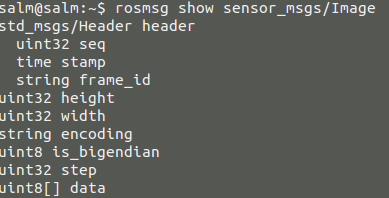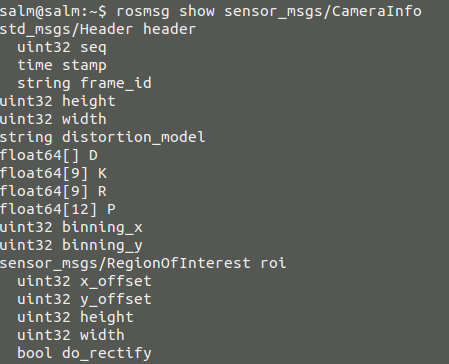记录关于我们运行roslaunch openni_launch openni.launch 命令时生成的话题以及这些话题的数据类型便于后期的处理,只有知道它们的数据结构,才能很好的对数据进行处理,我们观察到使用rostopic list的所有话题的列表,当然其中也有一些不经常使用的话题类型,比如下面这些话题是我们经常使用的
/camera/depth/image
/camera/depth/image_raw
/camera/depth/points
/camera/ir/image_raw
/camera/rgb/image_color
/camera/rgb/image_raw
发布的话题:
image_raw (sensor_msgs/Image) : 未处理的原始图像
使用命令查看sensor_msgs/Image的数据

camera_info (sensor_msgs/CameraInfo):包含了相机标定配置以及相关数据

介绍几个ROS节点运行的几种工具。他们的作用是ROS格式点云或包与点云数据(PCD)文件格式之间的相互转换。
(1)bag_to_pcd
用法:rosrun pcl_ros bag_to_pcd <input_file.bag> <topic> <output_directory>
读取一个包文件,保存所有ROS点云消息在指定的PCD文件中。
(2)convert_pcd_to_image
用法:rosrun pcl_ros convert_pcd_to_image <cloud.pcd>
加载一个PCD文件,将其作为ROS图像消息每秒中发布五次。
(3) convert_pointcloud_to_image
用法:rosrun pcl_ros convert_pointcloud_to_image input:=/my_cloud output:=/my_image
查看图像:rosrun image_view image_view image:=/my_image
订阅一个ROS的点云的话题并以图像的信息发布出去。
(4)pcd_to_pointcloud
用法:rosrun pcl_ros pcd_to_pointcloud <file.pcd> [ <interval> ]
-
<file.pcd> is the (required) file name to read.
-
<interval> is the (optional) number of seconds to sleep between messages. If <interval> is zero or not specified the message is published once.
加载一个PCD文件,发布一次或多次作为ROS点云消息
(5)pointcloud_to_pcd
例如: rosrun pcl_ros pointcloud_to_pcd input:=/velodyne/pointcloud2
订阅一个ROS的话题和保存为点云PCD文件。每个消息被保存到一个单独的文件,名称是由一个可自定义的前缀参数,ROS时间的消息,和以PCD扩展的文件。
那么我们使用一个简单的例子来实现在ROS中进行平面的分割,同时注意到使用的数据转换的使用
/************************************************************************** 关于使用pcl/PointCloud<T>的举例应用。这一类型的数据格式是PCL库中定义的一种数据格式 这里面使用了两次数据转换从 sensor_msgs/PointCloud2 到 pcl/PointCloud<T> 和 从 pcl::ModelCoefficients 到 pcl_msgs::ModelCoefficients. ************************************************************************/ #include <iostream> //ROS #include <ros/ros.h> // PCL specific includes #include <sensor_msgs/PointCloud2.h> #include <pcl_conversions/pcl_conversions.h> #include <pcl/ros/conversions.h> #include <pcl/point_cloud.h> #include <pcl/point_types.h> #include <pcl/io/pcd_io.h> //关于平面分割的头文件 #include <pcl/sample_consensus/model_types.h> //分割模型的头文件 #include <pcl/sample_consensus/method_types.h> //采样一致性的方法 #include <pcl/segmentation/sac_segmentation.h> //ransac分割法 ros::Publisher pub; void cloud_cb (const sensor_msgs::PointCloud2ConstPtr& input) { // 将点云格式为sensor_msgs/PointCloud2 格式转为 pcl/PointCloud pcl::PointCloud<pcl::PointXYZ> cloud; pcl::fromROSMsg (*input, cloud); //关键的一句数据的转换 pcl::ModelCoefficients coefficients; //申明模型的参数 pcl::PointIndices inliers; //申明存储模型的内点的索引 // 创建一个分割方法 pcl::SACSegmentation<pcl::PointXYZ> seg; // 这一句可以选择最优化参数的因子 seg.setOptimizeCoefficients (true); // 以下都是强制性的需要设置的 seg.setModelType (pcl::SACMODEL_PLANE); //平面模型 seg.setMethodType (pcl::SAC_RANSAC); //分割平面模型所使用的分割方法 seg.setDistanceThreshold (0.01); //设置最小的阀值距离 seg.setInputCloud (cloud.makeShared ()); //设置输入的点云 seg.segment (inliers, coefficients); //cloud.makeShared() 创建一个 boost shared_ptr // pcl_msgs::fromROSMsg(const sensor_msgs::PointCloud2 &, pcl::PointCloud<T>&); //pcl::io::savePCDFileASCII("test_pcd.pcd",cloud); // 把提取出来的内点形成的平面模型的参数发布出去 pcl_msgs::ModelCoefficients ros_coefficients; pcl_conversions::fromPCL(coefficients, ros_coefficients); pub.publish (ros_coefficients); } int main (int argc, char** argv) { // Initialize ROS ros::init (argc, argv, "my_pcl_tutorial"); ros::NodeHandle nh; // Create a ROS subscriber for the input point cloud ros::Subscriber sub = nh.subscribe ("input", 1, cloud_cb); // Create a ROS publisher for the output model coefficients pub = nh.advertise<pcl_msgs::ModelCoefficients> ("output", 1); // Spin ros::spin (); }
在这里我们的input就是要订阅的话题/camera/depth/points
我们在rosrun 的时候注明input:=/camera/depth/points的这样就可以使用kienct发布的点云数据,同时你也可以指定点云的数据